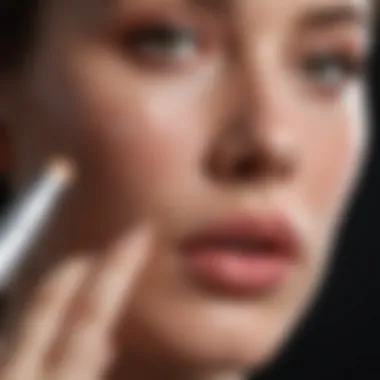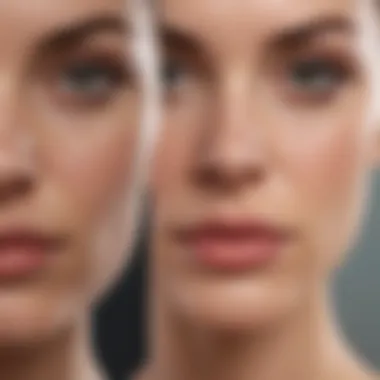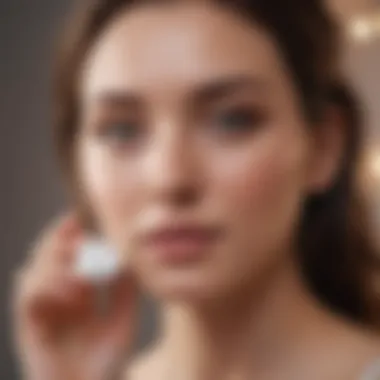Cover Up a Cold Sore: Effective Strategies Revealed


Intro
Cold sores can be distressing. They often appear unexpectedly, causing discomfort and self-consciousness. Understanding how to effectively conceal them can offer some relief from social anxiety. This article will delve into methods for covering up cold sores. We will cover the nature of cold sores, provide practical application tips for makeup, and suggest some products that can help.
Effective strategies can make the difference between feeling exposed and confident in social situations. Keeping cold sores discreet not only helps in public but may also assist in psychological well-being. Let’s explore what can be done.
Fashion Trends & Style Guides
While covering cold sores, it might not seem evident that fashion can play a role. However, choosing the right clothing and accessories can subtly divert attention from facial imperfections. Below are some suggestions.
Latest Fashion Trends
Opt for styles that enhance your overall look. Bright scarves or statement pieces can draw attention away from your face. Current trends favor layered clothing, so incorporating a chic jacket can also serve a dual purpose.
Seasonal Style Guides
In colder months, heavier fabrics like wool and cashmere can not only keep you warm but also create an elegant silhouette. During summer, try wide-brimmed hats as they provide shade for the face, making any visible cold sore less noticeable.
Accessories & Styling Tips
When it comes to accessories:
- Choose bold earrings or necklaces that capture attention.
- Makeup tools, especially brushes and sponges, should always be clean. This minimizes any risk of irritation around the mouth.
- A good UV-protective lip balm can help prevent outbreaks, especially during sunny days.
Beauty & Wellness
The right makeup application can mask a cold sore effectively. Applying the right techniques and products can be essential to manage visibility.
Beauty Product Reviews
Consider using products like Nars Radiant Creamy Concealer or MAC Studio Fix Fluid Foundation. These have full coverage and can hide imperfections quite effectively.
Skincare Routine Tips
Maintaining a skincare routine helps in managing outbreaks:
- Cleanse regularly with gentle products.
- Hydrate the area around your lips to prevent dryness.
- Aloe vera can help soothe the skin after a breakout.
Makeup Tutorials
- Begin with a clean, moisturized face.
- Apply a color-correcting concealer to balance any redness.
- Use a small brush to dab on your foundation, ensuring not to over-apply, as this can make the sore stand out more.
- Set your makeup with a light powder for long-lasting coverage.
"The key is to enhance your natural beauty, not to mask it entirely."
The End
Cold sores are common, but managing their appearance is possible. By using appropriate fashion choices and effective makeup techniques, individuals can navigate social situations confidently. Always remember, preventive measures are equally important to minimize future occurrences. Stay informed and choose what works best for you.
Understanding Cold Sores
Cold sores are a common issue many individuals face at some point in their lives. Understanding what cold sores are, their causes, and the lifecycle can greatly help in managing them. This section is important as it provides a foundation for the entire article. Knowing how cold sores manifest and their triggers can lead to more effective strategies for coverage.
What are Cold Sores?
Cold sores, also known as fever blisters, are small, fluid-filled lesions that appear on or around the lips. They are caused by the herpes simplex virus, primarily type 1, although type 2 can also be a factor. They usually start with a tingling or burning sensation, which is often a prelude to their appearance. On average, cold sores last around 7 to 10 days, but they can be bothersome and unsightly, prompting the desire for effective coverage methods.
Common Causes and Triggers
Several factors can lead to cold sore outbreaks. These triggers can vary per person but often include:
- Stress: Emotional or physical stress can weaken the immune system, leading to outbreaks.
- Illness: Other illnesses or infections can trigger an outbreak as the body’s defenses are compromised.
- Hormonal Changes: Changes such as those that occur during menstruation can provoke a cold sore.
- Sun Exposure: Prolonged exposure to sunlight can damage skin cells, triggering the virus.
- Fatigue: Lack of sleep can weaken the immune response, making outbreaks more likely.


Awareness of these triggers can aid individuals in managing their risk and implementing preventive measures.
The Lifecycle of a Cold Sore
Understanding the lifecycle of a cold sore is crucial for knowing when to act. This lifecycle is broken down into several stages:
- Prodromal Stage: As stated earlier, this is a warning phase when a person may feel tingling or itching. This period often lasts for a few hours.
- Blister Formation: After the prodromal symptoms, small blisters typically develop, often clustered together. This stage lasts a few days.
- Weeping and Crusting: After a few days, the blisters may burst, releasing fluid. They will eventually dry out, forming a crust.
- Healing Stage: The crust will fall off, and healing takes place underneath. This final healing phase can take a few more days to weeks.
Understanding this lifecycle helps in planning coverage techniques with minimal disruption during each stage.
Psychological Impact of Cold Sores
Cold sores can have a significant psychological impact on individuals who experience them. It is important to acknowledge that beyond the physical discomfort, the emotional and social ramifications of cold sore outbreaks can influence various aspects of a person's life. Understanding this psychological dimension helps highlight the importance of effective concealment strategies, as the quest for confidence and self-esteem often drives individuals to seek practical solutions.
Social Stigma Surrounding Cold Sores
The social stigma associated with cold sores is deeply rooted in misconceptions about their causes and implications. People often mistakenly associate cold sores with poor hygiene or contagiousness in a more general sense. This stigma can lead to feelings of embarrassment or shame for those affected, impacting their willingness to engage in social interactions.
The fear of judgment can be overpowering. Many individuals avoid social gatherings or refrain from certain activities, leading to isolation. Overcoming this stigma is not just a matter of personal resilience, but also a significant aspect of addressing the emotional toll of living with cold sores. Education and awareness are critical to breaking down these barriers.
Strategies for managing this stigma might include open conversations with close friends or peers, aiming to normalize the experience and reduce feelings of isolation. Here are a few points to consider that can help combat this stigma:
- Educate: Inform others about the true nature of cold sores. This can lessen misunderstandings and promote empathy.
- Normalize: Sharing experiences can foster a supportive environment, reducing feelings of being alone.
- Seek support: Joining online forums or communities, such as those found on reddit.com, can provide a sense of belonging.
Emotional Responses to Breakouts
When a cold sore emerges, it can trigger a range of emotional responses, from anxiety to frustration. The anticipation of a breakout can create stress, and the presence of an active sore often exacerbates these emotions. For many, the initial rush of embarrassment might escalate into anxiety about how others perceive them, particularly in professional or romantic settings.
Furthermore, individuals may experience fluctuations in self-esteem. A noticeable cold sore can overshadow one’s self-image, leading to bouts of self-doubt. For some, it may also become a recurring source of anxiety, affecting their overall mental health.
Here are common emotional reactions during a cold sore outbreak:
- Shame: Feeling embarrassed about the appearance can lead to withdrawal from social situations.
- Frustration: The recurring nature of cold sores may cause irritation, particularly if a breakout occurs at an inconvenient time.
- Anxiety: Concerns about how others will react may trigger anticipatory anxiety before social events or meetings.
Recognizing and validating these emotional responses is crucial. It encourages individuals to address their feelings healthily. Techniques such as mindfulness or stress-reduction strategies can be effective in managing these emotions. Engaging in self-care routines will also serve to enhance overall mental well-being during difficult times.
"Addressing the emotional side of dealing with cold sores is just as vital as physical treatment."
In summary, understanding the psychological impact of cold sores allows for a more comprehensive approach to managing them. By addressing the social stigma and emotional responses associated with outbreaks, individuals can build a better framework for coping and ultimately find effective strategies for covering them up.
Preparation for Concealing a Cold Sore
Concealing a cold sore effectively involves more than just applying makeup; it requires a strategic approach. Preparation is a critical step that dictates the outcome of your concealment efforts. By taking the time to assess the severity of the cold sore and gathering the necessary tools, you can achieve a more seamless and natural appearance. This section highlights the importance of preparation and guides readers through the essential steps.
Assessing Cold Sore Severity
Before diving into any form of coverage, it is vital to assess the severity of the cold sore. Different stages of a cold sore require distinct approaches. The stages include the initial tingling sensation, the blister stage, and the healing phase.
- Initial Stage: At this point, a cold sore may present with swelling, itching, or tingling. Although not visibly prominent, starting treatment here can help reduce its severity.
- Blister Stage: This is the most visible stage, characterized by the appearance of fluid-filled blisters. This phase often demands the most attention when concealing.
- Healing Phase: The blister may have burst and begun to scab over, which can still draw attention. The goal here is to minimize visibility without further irritation.
Understanding the state of your cold sore allows you to tailor your concealment approach. For example, if the sore is still in the blister stage, utilizing thicker coverage might be necessary.
Gathering Necessary Tools and Products
Once you have evaluated the severity, the next step is to gather your tools and products. Selection plays a significant role in the effectiveness of your coverage. Here is a list of essential items:
- Makeup Foundation: Look for options that provide full coverage. This can help to mask the color and texture of the lesion.
- Concealer: A thicker consistency is preferred. A green-tinted concealer can neutralize redness.
- Setting Powder: This helps to set the makeup, making it less likely to smudge or wear off during the day.
- Tools: Brushes or sponges for application make a significant difference. Choose a small brush for precise application on the sore.
- Topical Treatments: Consider incorporating soothing balms or ointments that help to promote healing while providing coverage.
The right combination of products will not only help conceal the cold sore but also prevent further irritation. This preparation stage is crucial to achieving a polished look while addressing the cold sore's visibility.
"Preparation is key when it comes to effectively concealing a cold sore. Knowing what products to use can make a noticeable difference."


Taking these steps ensures you are ready to tackle the next phase—applying makeup techniques skillfully and effectively.
Makeup Techniques for Covering a Cold Sore
Makeup can play a crucial role in effectively concealing cold sores. The right techniques and products help in minimizing visibility while boosting confidence. Applying makeup over a cold sore requires a careful approach as the skin can be sensitive and irritated. Therefore, employing proper techniques is not just about hiding the sore but also ensuring skin health and comfort.
Choosing the Right Foundation
Selecting an appropriate foundation is vital when there is a cold sore present. A foundation that is lightweight and buildable is preferable. Liquid foundations tend to offer a more natural finish compared to powder. This is important as powders can settle into cracks, drawing more attention to the sore. Consider using a foundation with a matte finish to reduce shine, which can be more noticeable in breakout areas.
When selecting a shade, match it closely to your natural skin tone. Avoid foundations that have a high SPF; while sun protection is beneficial, it can sometimes flash back in photographs, causing the cold sore to stand out.
Application Techniques
Application techniques greatly impact how well the foundation conceals a cold sore. First, start with a clean face. Apply a lightweight moisturizer or primer to create a smooth base. Use a damp makeup sponge to apply foundation. The sponge helps to press the product into the skin without disturbing the sore.
It's key to use a stippling motion rather than rubbing. Apply the foundation gently around the cold sore, blending it towards the outer edges. This approach helps prevent the sore from being disturbed while ensuring even coverage.
Avoid covering the cold sore with excess product, as this may lead to caking. A light touch is best, reapplying as needed for additional coverage.
Using Concealer Effectively
Once the foundation is in place, a high-coverage concealer will further enhance the concealment of the cold sore. Choose a concealer that is one shade lighter than your foundation for a natural look. Apply it directly onto the cold sore using a clean brush or fingertip.
First, gently dab the concealer onto the sore, then blend the edges carefully into the surrounding skin. To set the concealer, use a translucent powder sparingly. This helps maintain the coverage without adding texture.
Tip: Carry a small concealer stick for touch-ups throughout the day to maintain the coverage.
Effective use of makeup techniques will not only help in covering a cold sore but also assist in maintaining overall skin health. Understanding product choices and application methods is essential in this delicate process.
Complementary Products for Cold Sore Coverage
When dealing with cold sores, complementary products play a crucial role in enhancing coverage and comfort during an outbreak. These products not only help in hiding the appearance of the sore but also promote healing and provide relief from the associated discomfort. Utilizing the correct products can make a considerable difference and ensure you feel more confident in social situations.
Topical Treatments
Topical treatments are an essential aspect when addressing cold sores. They serve dual purposes: treating the sore itself and preparing your skin for further application. Look for products that contain antiviral agents, like docosanol or acyclovir, which can speed up healing. Other soothing ingredients include aloe vera and vitamin E, which may help lessen irritation.
It is important to apply these treatments as soon as you notice signs of a cold sore. This prevents further development and reduces the duration of visibility. Here are some key points to consider when selecting topical treatments:
- Effectiveness: Choose treatments with proven active ingredients.
- Skin Type: Consider your skin type when selecting a product. Sensitive skin may require a gentler formula.
- Application: Follow the instructions diligently for the best results.
"The right topical treatment can significantly minimize the visual impact of a cold sore."
Lip Products and Balms
Lip products and balms are equally important in covering a cold sore. These products provide moisture and protection and can be a barrier against further irritation. Look for some balms that contain sunscreens to prevent UV damage, which can make cold sores more noticeable and worsen healing. Lipsticks and tinted balms can bring a more cohesive appearance to your lips, making cold sores less prominent.
Here are some options to consider:
- Hydrating Lip Balms: Opt for those with natural ingredients to soothe and hydrate the area.
- Tinted Lip Products: These can help mask the cold sore while providing color.
- Non-Matte Formulas: Glossy lip products reflect light differently, drawing less attention to the sore.
When using these products, be mindful to avoid overapplying directly on the sore itself, as this might lead to further irritation or infection.
Additional Strategies for Minimizing Visibility
Addressing the visibility of a cold sore extends beyond makeup applications and topical treatments. Practical strategies can help reduce attention to the affected area, allowing individuals to feel more confident. This section dives into how clothing choices and accessory selections can play a vital role in covering up a cold sore, thus enhancing overall appearance while maintaining comfort.
Choosing Appropriate Clothing
Selecting the right attire can greatly influence how a cold sore appears to others. Opting for high-collared shirts or scarves allows for better coverage of the lower face.


- Fabric Choices: Selecting soft, breathable materials can help minimize irritation around the sore. Cotton or modal is gentle on the skin and ensures comfort throughout the day.
- Color Considerations: Wearing darker colors can divert focus away from the face. Earthy tones and muted shades tend to blend well together, drawing eyes away from specific facial features.
- Layering: Layering clothing not only provides more coverage but can interrupt visual flow. Avoiding high-contrast patterns near the face can help maintain a smooth visual line.
Utilizing Accessories
Accessories can significantly enhance outfits while also serving practical purposes in covering a cold sore.
- Scarves and Shawls: These can act as a perfect divider between the sore and the observer's gaze. Light, flowy scarves can be stylish while adding essential coverage.
- Earrings and Necklaces: Statement earrings or bold necklaces can draw the eye upwards, directing attention away from the mouth area. This tactic shifts focus without compromising personal style.
- Hats and Headbands: These items not only add a fashion-forward flair but also help retain warmth and create shading that impulsively affects visibility.
Utilizing these strategies ensures that ever present cold sore does not dictate the perceived confidence of individuals.
"Choosing the right clothing and accessories can transform not just how others see you, but how you perceive yourself as well."
Integrating these simple yet effective tactics can make a significant difference in reducing the visibility of cold sores while helping individuals maintain a sense of normalcy during breakouts.
Maintaining Healthy Skin Post-Breakout
Maintaining healthy skin after a cold sore breakout is crucial. After the sore heals, the skin might still be sensitive and more susceptible to irritation or new outbreaks. A proper skincare routine can help restore skin’s natural balance, prevent future issues, and address any lingering discoloration. This part of the article will outline key practices to consider for optimal skin health following a cold sore event.
Care After the Sore Heals
Once a cold sore has closed, it does not mean that skin care is no longer necessary. In fact, it is arguably more important than ever. Here are several steps to follow after the sore has healed:
- Gentle Cleansing: Use a mild, fragrance-free cleanser to clean the affected area. Harsh soaps can lead to further irritation.
- Hydration: Moisturizing is vital. Look for products that contain ceramides or hyaluronic acid, as they can help in rebuilding the skin barrier.
- Sun Protection: Apply sunscreen to the area daily. UV rays can trigger outbreaks and worsen discoloration. A broad-spectrum sunscreen of SPF 30 or higher is recommended.
- Treatment of Discoloration: Consider using products that promote skin renewal. Ingredients like Vitamin C or retinol can help reduce any lingering redness or dark spots left behind.
After properly caring for the area, it is also essential to pay attention to your skin's reaction. If there is noticeable discomfort or irritation, consulting a dermatologist may provide additional tailored advice.
Preventing Future Breakouts
Preventing future cold sore outbreaks is essential for maintaining healthy skin. Here are strategies to minimize the chances of experiencing another breakout:
- Avoid Triggers: Identify and avoid personal triggers, which might include stress, certain foods, or even seasonal changes. Keeping a diary may help track these.
- Stress Management: Practice relaxation techniques. Stress can weaken the immune system, making it more difficult for the body to fend off viruses.
- Healthy Lifestyle Choices: Eat a balanced diet rich in vitamins and antioxidants. Regular exercise and adequate sleep also play a role in strengthening the immune system.
- Topical Preventatives: Consider using antiviral creams as a preventive measure if you are prone to frequent outbreaks. Consulting a healthcare provider for recommendations is advised.
By adhering to these practices, individuals can protect their skin and reduce the likelihood of future cold sore incidences. It is about creating a holistic approach to skin care and health.
When to Seek Professional Help
Recognizing when to seek professional help regarding cold sores is crucial for both physical and emotional well-being. Not all cases require medical intervention, but knowing when to reach out can prevent complications from arising. Understanding the signs of complications and knowing healthcare options can ensure effective management of cold sores.
Identifying Complications
Cold sores typically heal on their own within a few weeks. However, certain symptoms may indicate that a cold sore requires professional attention. These symptoms can include:
- Severe Pain: If the pain escalates beyond discomfort, it might mean an infection or other complications need evaluation.
- Prolonged Outbreaks: Cold sores should generally resolve in about two weeks. Extended outbreaks may signal an underlying issue.
- Increased Frequency of Recurrences: If cold sores become more frequent or severe with time, a deeper cause may need investigation.
- Signs of Infection: Pus, excessive redness, or fever can indicate secondary infections needing treatment.
- Cold Sores Affecting Eyes: If a cold sore spreads to the eye area, medical care should be sought immediately.
Understanding these warning signs can help individuals determine if professional help is necessary to avoid further complications.
Consulting a Healthcare Provider
When faced with complications or persistent issues, consulting a healthcare provider is essential. A healthcare provider can offer assessments and treatment options tailored to the individual’s needs. The benefits of seeking professional help include:
- Diagnosis: A proper diagnosis can confirm whether the symptom is a common cold sore or something more serious.
- Treatment Options: Healthcare providers can prescribe antiviral medications to help control outbreaks and alleviate symptoms effectively. They often recommend topical treatments that are more effective than OTC products.
- Preventive Advice: Providers can offer guidelines on how to manage triggers, improve skin health, and prevent future outbreaks.
- Mental and Emotional Support: Since cold sores can affect self-esteem, healthcare providers may also assist in addressing emotional impacts and offer referrals to mental health professionals if needed.
"Seeking timely help can significantly enhance quality of life and overall health, especially when complications arise."
By keeping an eye on symptoms and consulting professionals when necessary, individuals can navigate the challenges posed by cold sores effectively.
The End
Summarizing Key Takeaways
- Knowledge about Cold Sores: Being informed on what cold sores are and their triggers is essential. By recognizing the symptoms early, one can better prepare for management.
- Effective Preparation: Assessing the severity of the cold sore and gathering the necessary tools and products are foundational steps.
- Makeup Application Techniques: Choosing the right makeup products and using effective application methods can significantly minimize the appearance of cold sores. This includes foundation, concealer, and thoughtful techniques for layering.
- Complementary Products: Utilizing topical treatments and lip products can offer both treatment and coverage, enhancing overall appearance and comfort.
- Maintaining Skin Health: It is crucial to care for the skin after a breakout and take preventive measures to reduce the frequency of occurrences.
Final Thoughts on Cold Sore Management
In closing, effective cold sore management includes both immediate solutions for covering the sore and long-term strategies for skin health. By incorporating various techniques and understanding the nature of cold sores, individuals can feel empowered. Furthermore, recognizing when to seek professional help can prevent complications and ensure proper care.
By applying the insights shared, individuals can gain confidence in managing cold sores, emphasizing the importance of not just appearance but also overall skin health and well-being. The combination of informed strategies and emotional resilience equips one to handle cold sore outbreaks more gracefully.







